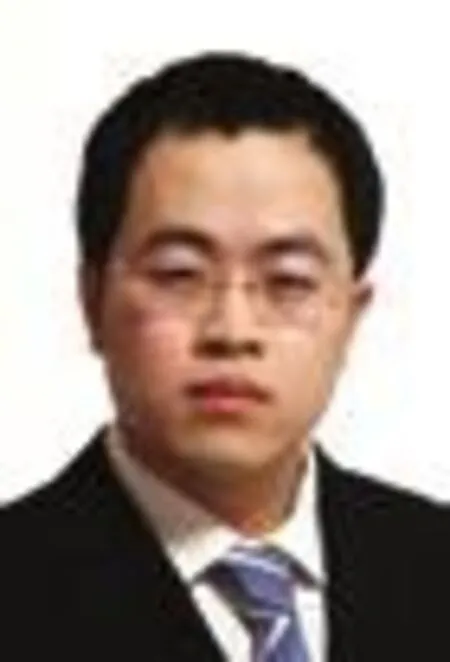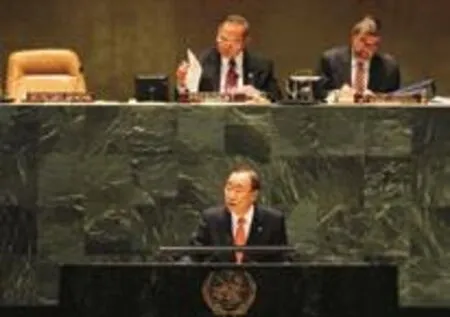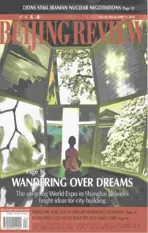An Ending and a New Start
2010-09-12ByLIUCHONG
By LIU CHONG
An Ending and a New Start
By LIU CHONG
The 2010 Nuclear Non-proliferation Treaty Review Conference is a milestone for international arms control efforts

COURTESY OF LIU ChONG
Th e 2 0 1 0 Nuclear Nonproliferation Treaty (NPT) Review Conference (RevCon) at the UN headquarters in New York from May 3-28, in many analysts’eyes, was a glorious epilogue for the past year.
At the conference, the 189 member nations to the NPT approved a 28-page final document that advanced a realistic path to achieve the goal of a world without nuclear weapons.
RevCons have been held at five-year intervals since the NPT came into force in 1970. Each conference sought to come up with a fnal document that would assess the implementation of the NPT’s provisions and make recommendations on measures to make it stronger.
The 1995 RevCon adopted an indefnite extension of the NPT. In 2000, the parties successfully agreed on a 13-point action plan as a fnal document.
But, at the 2005 RevCon, mainly because of the Bush administration’s objections, even compromising on the conference agenda became a hard task, and a fnal document was unable to be reached.
And this year’s conference has demonstrated a number of distinctive features:
Positive atmosphere
Upon assuming office, U.S. President Barack Obama offcially advocated the concept of “a world free of nuclear weapons” in Prague in April 2009.
Following his Prague speech, a series of historic events took place. In September 2009, the UN Security Council held a summit on nuclear non-proliferation and disarmament, and unanimously adopted Resolution 1887. With this resolution, the Security Council seeks “a safer world for all and to create the conditions for a world without nuclear weapons in accordance with the goals of the NPT.”
On April 6, this year, the U.S Department of Defense released a new strategic document—the Nuclear Posture Review. Two dayslater, Obama and Russian President Dmitry Medvedev signed a new Strategic Arms Reduction Treaty (START) to reduce stockpiles of deployed strategic nuclear weapons and set new procedures to verify the weapons each country possessed.
On April 12-13, the 2010 Nuclear Security Summit was held in Washington, D.C. It concluded with a comprehensive communiqué and a practicable work plan, which laid foundations for future cooperation.
In addition to these events, many countries and non-governmental organizations have made tremendous efforts to push forward the “nuclear weapon-free” process. For instance, Britain published two policy papers on nuclear disarmament.
Japan and Australia jointly established the International Commission on Nuclear Non-proliferation and Disarmament, which published a practical report for global policymakers. Ireland, Sweden, Norway and other nations allied to the United States also showed support for the elimination of nuclear weapons.
Global Zero, the most active NGO in nuclear disarmament, held two meetings in Paris attended by distinguished experts and political leaders.
China has also been actively involved in this process. President Hu Jintao attended both the UN Security Council’s summit on nuclear non-proliferation and disarmament last year and the Nuclear Security Summit in April this year. Chinese Foreign Minister Yang Jiechi attended the Conference on Disarmament in Geneva in August last year. At these meetings, they articulated China’s policies and proposals on nuclear arms control issues.
Right direction

OPENING OFTHECONFERENCE: UN Secretary General Ban Kimoon addresses the 2010 Nuclear Non-proliferation Treaty Review Conference at the UN headquarters in New York on May 3
The 2010 RevCon moved in the right direction by treating the NPT’s three pillars as a whole, especially linking disarmament and non-proliferation again.
The NPT regime has an inherently discriminatory nature: Some states can have nuclear weapons while others cannot. Nuclear disarmament, non-proliferation, and peaceful use of nuclear energy are the NPT’s three pillars, with each one linked to the others.
If nations with nuclear weapons cannot fulfll their nuclear disarmament and elimination obligations under Article VI, adhering to non-proliferation obligations will be meaningless for nations without nuclear weapons.
But this basic logic has been ignored in the last decade. The Bush administration enforced a unilateral security policy and took stress off nonproliferation issues. This practice hurt the NPT regime badly and made proliferation worse, as evidenced by North Korea and Iran.
The Obama administration reversed this worrying trend. In his closing remarks at the Nuclear Security Summit, Obama said,“Leadership and progress in one area reinforces progress in another... When the United States fulflls its responsibilities as a nuclear power committed to the NPT, we strengthen our global efforts to ensure that other nations fulfll their responsibilities.”
On May 6, the fve permanent members of the UN Security Council told the 2010 RevCon:“We reaffrm our enduring commitment to the fulfllment of our obligations under Article VI of the NPT and our continuing responsibility to take concrete and credible steps towards irreversible disarmament.”
Those constructive statements and activities may appease the discontent of nations without nuclear weapons. This effect of demonstration is exactly what the United States wants. In its 2010 Nuclear Posture Review, the United States placed“preventing nuclear proliferation and nuclear terrorism” atop its nuclear agenda for the frst time.
All the efforts the United States has recently made in nuclear disarmament have an ultimate goal—to facilitate international cooperation on preventing nuclear proliferation.
This eagerness was revealed in Obama’s statement at the 2010 RevCon, in which he said:“Building on our new START treaty with Russia and our Nuclear Posture Review, which reaffirms the central importanceof the NPT, the United States is meeting its responsibilities and setting the stage for further cuts. We will see whether nations without nuclear weapons will fulfll their obligation to forsake them.”
But it was still hard for the parties to compromise. Some experts even predicted the 2010 RevCon might collapse on its fnal day because of marked divergence among the parties. Fortunately, the nations could not accept another failure after the 2005 RevCon, and reached a consensus at the last minute.
Although the final document of the 2010 RevCon was carefully balanced to reflect demands by all parties, it shows significant achievements on measures toward disarmament and non-proliferation, especially a call to open talks in 2012 toward a nuclear weapon-free zone in the Middle East. By this fnal declaration, the international community showed a strong political will to build a safer and more secure world.
Civilian use
In recent years, to cope with climate change and as a solution to the energy crisis amid growing depletion of fossil fuels, nuclear energy has undergone globally an unprecedented expansion—a so-called “nuclear energy renaissance.”
Nuclear energy was first developed in a mostly constrained way in industrialized countries. In contrast, many developing countries now have great enthusiasm and ambitious plans for nuclear power plants. And the production of nuclear power may be tripled by 2050.
This vision brings up three problems connected to the NPT regime:
First, rapidly expanding quantities of nuclear materials will make the International Atomic Energy Agency’s (IAEA’s) security burden heavier. The amount of weapon-usable material under safeguards has increased six to 10 times during the last two decades, while the IAEA’s budget and personnel have expanded much more slowly.
If the quantity of nuclear materials increases dramatically in the near future, it may lead to a dangerous decline in the number of IAEA inspections at every protected facility.
Thus, strengthening the IAEA’s ability and protective role, as well as its capacity of instructing newcomers about nuclear energy development, should be made a priority. To that end, nations need to increase the budget for the IAEA while respecting the agency’s authority. The 2010 RevCon final document stressed the role of the IAEA in several paragraphs. For the frst time, it endorsed an additional protocol of the IAEA that aims to strengthen the agency’s safeguards.
Second, a nuclear energy renaissance may accelerate the proliferation of sensitive technologies. Uranium enrichment and spent fuel reprocessing have been considered major proliferation concerns. These concerns and the right to peaceful use of nuclear energy should be balanced. It would be appropriate for the parties to the NPT to develop a common understanding of building a voluntary, multilateral nuclear fuel cycle and supply mechanism. The final document supported efforts to pursue an agreement on international fuel banks and related multilateral mechanisms for assurance of nuclear fuel services.
Third, it will make the NPT’s loopholes more dangerous. Since parties have the right to withdraw from the NPT under Article X, a state could develop sensitive technologies under Article IV and then quit the NPT.
To fx this loophole, the fve permanent members of the UN Security Council have put forward a proposal in their joint statement to the 2010 RevCon. They called for the UN Security Council to address a situation where, even if any state party gives notice of withdrawal from the NPT, it would remain responsible under international law for violations of the NPT committed before it withdraws. The fnal document has recognized this view for the frst time in history.
For the last 40 years, the NPT has endured as the cornerstone of the non-proliferation regime and remains the only legally binding multilateral agreement on nuclear disarmament.
Many problems, however, continue to threaten global security today, such as the huge nuclear stockpiles of the United States and Russia, preemptive nuclear strategies and the increasing trends of proliferation and terrorism.
The unstable international security environment and the eagerness of most nations for a world without nuclear weapons have made the NPT regime more valuable than ever.
At the UN Security Council’s nuclear non-proliferation and disarmament summit last year, Chinese President Hu Jintao introduced a series of proposals, including maintaining a global strategic balance, giving up on the first use of nuclear weapons, and preventing the proliferation of nuclear weapons while respecting the right of countries to peaceful use of nuclear energy.
His proposals provided a practical guide for future international nuclear arms control cooperation. At the 2010 RevCon, Li Baodong, head of the Chinese delegation, reaffrmed these principles.
It is vital that the international community attach equal importance to nuclear disarmament, non-proliferation and security, while helping developing countries utilize nuclear energy. In doing so, the 2010 RevCon was not only a glorious epilogue, but a new starting place for further progress in ensuring humanity fully enjoys the convenience of nuclear energy in a more secure international environment.
The author is an assistant research fellow with the Institute of Arms Control and Security Studies at the China Institutes of Contemporary International Relations
